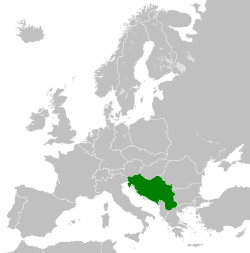FPR Yugoslavia
| Socialist Federal Republic of Yugoslavia | ||||||||||||||||||||
|
Socijalistička Federativna Republika Jugoslavija Социјалистичка Федеративна Република Југославија Socialistična federativna republika Jugoslavija |
||||||||||||||||||||
|
||||||||||||||||||||
|
||||||||||||||||||||
|
Motto Bratstvo i jedinstvo "Brotherhood and unity" |
||||||||||||||||||||
|
Anthem Hej, Slaveni Хеј, Словени "Hey, Slavs" |
||||||||||||||||||||
|
Yugoslavia in 1989
|
||||||||||||||||||||
| Capital | Belgrade | |||||||||||||||||||
| Languages |
Serbo-Croatian Slovene Macedonian |
|||||||||||||||||||
| Demonym | Yugoslav, Yugoslavian | |||||||||||||||||||
| Government | One-party socialist federal republic | |||||||||||||||||||
| President | ||||||||||||||||||||
| • | 1945–1953 | Ivan Ribar (first) | ||||||||||||||||||
| • | 1953–1980 | Josip Broz Tito | ||||||||||||||||||
| • | 1991 | Stjepan Mesić (last) | ||||||||||||||||||
| Prime Minister | ||||||||||||||||||||
| • | 1945–1953 | Josip Broz Tito (first) | ||||||||||||||||||
| • | 1989–1991 | Ante Marković (last) | ||||||||||||||||||
| General Secretary | ||||||||||||||||||||
| • | 1945–1980 | Josip Broz Tito (first) | ||||||||||||||||||
| • | 1989–1990 | Milan Pančevski (last) | ||||||||||||||||||
| Legislature | Federal Assembly | |||||||||||||||||||
| • | Upper house | Chamber of Republics | ||||||||||||||||||
| • | Lower house | Federal Chamber | ||||||||||||||||||
| Historical era | Cold War | |||||||||||||||||||
| • | Proclamation | 29 November 1945 | ||||||||||||||||||
| • | Constitution adopted | 31 January 1946 | ||||||||||||||||||
| • | Balkan Pact signed | 28 February 1953 | ||||||||||||||||||
| • | Death of Josip Broz Tito | 4 May 1980 | ||||||||||||||||||
| • | Disintegration | 27 April 1992 | ||||||||||||||||||
| Area | ||||||||||||||||||||
| • | 1989 | 255,804 km² (98,766 sq mi) | ||||||||||||||||||
| Population | ||||||||||||||||||||
| • | 1989 est. | 23,724,919 | ||||||||||||||||||
| Density | 92.7 /km² (240.2 /sq mi) | |||||||||||||||||||
| Currency | Yugoslav dinar | |||||||||||||||||||
| Internet TLD | .yu | |||||||||||||||||||
| Calling code | +38 | |||||||||||||||||||
|
||||||||||||||||||||
| Today part of |
|
|||||||||||||||||||
| a. | ^ Full name in the Serbo-Croatian language, written in the Latin alphabet (see Name section for details). | |||||||||||||||||||
| b. | ^ Full name in Serbo-Croatian and Macedonian, written in Cyrillic. | |||||||||||||||||||
| c. | ^ Full name in the Slovene language (Slovene only uses Latin). | |||||||||||||||||||
| d. | ^ There was no de jure official language at the federal level, but Serbo-Croatian was de facto official. It was also legally the official language in the federal republics of Serbia, Croatia, Bosnia and Herzegovina, and Montenegro. | |||||||||||||||||||
| e. | ^ Official in Slovenia. | |||||||||||||||||||
| f. | ^ Official in Macedonia. | |||||||||||||||||||
The Socialist Federal Republic of Yugoslavia (SFR Yugoslavia or SFRY) was the Yugoslav state that existed from its foundation in the aftermath of World War II until its dissolution in 1991 amid the Yugoslav Wars. It was a socialist state and a federation made up of six socialist republics: Slovenia, Croatia, Bosnia and Herzegovina, Serbia, Montenegro, and Macedonia. In addition, it included two autonomous provinces within Serbia: Kosovo and Vojvodina.
After initially siding with the Eastern bloc under the leadership of Josip Broz Tito at the beginning of the Cold War, Yugoslavia pursued a policy of neutrality after the Tito–Stalin split of 1948, and it became one of the founding members of the Non-Aligned Movement. After the death of Tito in 1980, rising ethnic nationalism in the late 1980s led to dissidence among the multiple ethnicities within the constituent republics, followed by collapse of inter-republic talks on transformation of the federation and recognition of their independence by some European states in 1991. This led to the federation collapsing along the federal borders, followed by the final downfall and breakup of the federation in 1992, and the start of the Yugoslav Wars. The term "former Yugoslavia" (bivša Jugoslavija) is now commonly used retrospectively.
...
Wikipedia



